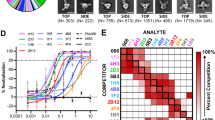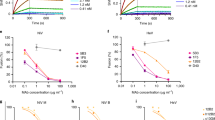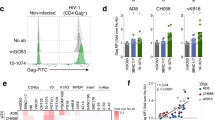Abstract
Sudan virus (genus Ebolavirus) is lethal, yet no monoclonal antibody is known to neutralize it. We here describe antibody 16F6 that neutralizes Sudan virus and present its structure bound to the trimeric viral glycoprotein. Unexpectedly, the 16F6 epitope overlaps that of KZ52, the only other antibody against the GP1,2 core to be visualized to date. Furthermore, both antibodies against this crucial epitope bridging GP1–GP2 neutralize at a post-internalization step—probably fusion.
This is a preview of subscription content, access via your institution
Access options
Subscribe to this journal
Receive 12 print issues and online access
$189.00 per year
only $15.75 per issue
Buy this article
- Purchase on Springer Link
- Instant access to full article PDF
Prices may be subject to local taxes which are calculated during checkout



Similar content being viewed by others
Accession codes
References
Sanchez, A. & Rollin, P.E. Virus Res. 113, 16–25 (2005).
Okware, S.I. et al. Trop. Med. Int. Health 7, 1068–1075 (2002).
Maruyama, T. et al. J. Infect. Dis. 179 Suppl 1, S235–S239 (1999).
Takada, A. et al. J. Virol. 77, 1069–1074 (2003).
Wilson, J.A. et al. Science 287, 1664–1666 (2000).
Shahhosseini, S. et al. J. Virol. Methods 143, 29–37 (2007).
Yu, J.S. et al. J. Virol. Methods 137, 219–228 (2006).
Volchkov, V.E., Feldmann, H., Volchkova, V.A. & Klenk, H.D. Proc. Natl. Acad. Sci. USA 95, 5762–5767 (1998).
Jeffers, S.A., Sanders, D.A. & Sanchez, A. J. Virol. 76, 12463–12472 (2002).
Dube, D. et al. J. Virol. 83, 2883–2891 (2009).
Hood, C.L. et al. J. Virol. 84, 2972–2982 (2010).
Lee, J.E., Fusco, M.L., Hessell, A.H., Burton, D.R. & Saphire, E.O. Acta Crystallogr. D 65, 1162–1180 (2009).
Lee, J.E. et al. Nature 454, 177–182 (2008).
Halfmann, P. et al. Proc. Natl. Acad. Sci. USA 105, 1129–1133 (2008).
Chandran, K., Sullivan, N.J., Felbor, U., Whelan, S.P. & Cunningham, J.M. Science 308, 1643–1645 (2005).
Schornberg, K. et al. J. Virol. 80, 4174–4178 (2006).
Weissenhorn, W., Carfi, A., Lee, K.H., Skehel, J.J. & Wiley, D.C. Mol. Cell 2, 605–616 (1998).
Malashkevich, V.N. et al. Proc. Natl. Acad. Sci. USA 96, 2662–2667 (1999).
Ekiert, D.C. et al. Science 324, 246–251 (2009).
Sui, J. et al. Nat. Struct. Mol. Biol. 16, 265–273 (2009).
Acknowledgements
We thank D. Burton and A. Hessell (The Scripps Research Institute, TSRI) for KZ52, M. Whitt (University of Tennessee Health Science Center) and D. Lyles (Wake Forest University School of Medicine) for anti-VSV IgG 23H12, J. Cunningham (Brigham and Women's Hospital) for rabbit anti-GP1 polyclonal antibody and I. Wilson of TSRI for critical reading of the manuscript. We would also like to thank C. Corbaci (TSRI) for assistance in figure preparation and the staff of the Advanced Photon Source Beamline 19-ID and the Advanced Light Source Beamlines 8.2.2 and 8.3.1 for assistance and for the use of their US Department of Energy–supported facilities. E.O.S. wishes to acknowledge US National Institutes of Health (NIH) grant U01 AI070530, the Skaggs Institute for Chemical Biology, a Career Award in the Biomedical Sciences and an Investigator in the Pathogenesis of Infectious Disease Award from the Burroughs Welcome Fund. K.C. acknowledges support from NIH grants R01 AI088027 and R21 AI082437 and from institutional funds of the Albert Einstein College of Medicine. A.C.W. was supported by NIH training grants T32 GM007288 and T32 AI070117. Y.K. acknowledges support from NIH R01 AI055519 and membership within and support from the Region V 'Great Lakes' Regional Center for Excellence for Biodefense and Emerging Infectious Diseases Research (RCE) Program (NIH award 2 U54 AI057153). J.M. Dye wishes to acknowledge support from the Defense Threat Reduction Agency (DTRA K.K0001_07_RD_B). Opinions, interpretations, conclusions and recommendations are those of the authors and are not necessarily endorsed by the US Army.
Author information
Authors and Affiliations
Contributions
J.M. Dias determined the crystal structure, S.B. continued refinement and M.L.F. engineered SUDV GP1,2 for crystallization. A.I.K., E.K., S.E.Z., M.A.M. and J.M. Dye raised 16F6 and designed and conducted BSL-4 neutralization and protection experiments. D.M.A., E.O.S., A.C.W. and K.C. designed and carried out cathepsin cleavage and VSIV neutralization experiments. D.M.A., E.O.S., P.H. and Y.K. designed and conducted attachment and entry experiments. J.M. Dias, J.M. Dye, D.M.A., S.B., A.K., K.C., P.H., Y.K. and E.O.S. analyzed results. J.M. Dye, K.C., Y.K. and E.O.S. supervised the research. J.M. Dias, J.M. Dye and E.O.S. wrote the manuscript.
Corresponding authors
Ethics declarations
Competing interests
The authors declare no competing financial interests.
Supplementary information
Supplementary Text and Figures
Supplementary Figures 1–7, Supplementary Table 1 and Supplementary Methods (PDF 2193 kb)
Rights and permissions
About this article
Cite this article
Dias, J., Kuehne, A., Abelson, D. et al. A shared structural solution for neutralizing ebolaviruses. Nat Struct Mol Biol 18, 1424–1427 (2011). https://doi.org/10.1038/nsmb.2150
Received:
Accepted:
Published:
Issue Date:
DOI: https://doi.org/10.1038/nsmb.2150
This article is cited by
-
Glycan shield of the ebolavirus envelope glycoprotein GP
Communications Biology (2022)
-
Single-component multilayered self-assembling nanoparticles presenting rationally designed glycoprotein trimers as Ebola virus vaccines
Nature Communications (2021)
-
Potential neutralizing antibodies discovered for novel corona virus using machine learning
Scientific Reports (2021)
-
Pseudotyping of VSV with Ebola virus glycoprotein is superior to HIV-1 for the assessment of neutralising antibodies
Scientific Reports (2020)
-
Antibody responses to viral infections: a structural perspective across three different enveloped viruses
Nature Microbiology (2019)



